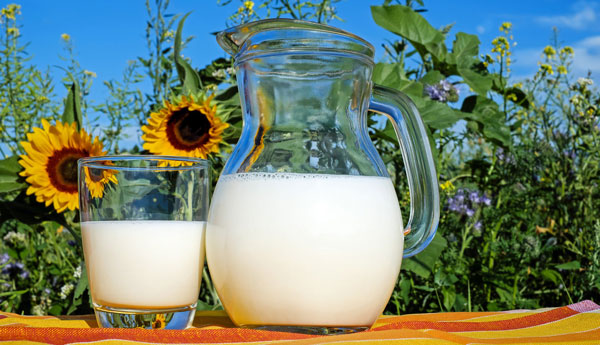
Its the time of year when many ranchers are weaning calves away from their mothers. While this can result in quite a bit of bawling and, depending on where you calf pen is located, some sleepless nights, it also signals the beginning of a great time to start getting some pure, unpasteurized, unhomogenized cow milk for you and your family (provided you haven’t started already). You know, the kind where the cream rises to the top, and you can sneak to the kitchen and skim it off in the middle of the night, before anyone else gets to it? No, just me? Well you’re missing out, I promise you. Nonetheless, if you want some milk, and you aren’t already set up with a modern milking machine, you have to learn how to–well–milk; a process that is simultaneously easier than you’ve heard, and harder than it looks.
Weaning Age
While this is not an article on weaning, I’ve found that weaning at six months tends to yield a good balance between the health of the calf (they are generally strong enough to transition to water and good quality hay at that point), and milk production. Of course, I do know everyone’s requirements and timetables are different, so take that as you will.
Setup
You’ll want a way to quickly and easily retain the cow for milking.. The traditional method is called a milking stanchion. It is a simple stand with two wooden boards placed on the upright diagonal towards its front. They are held in place by two horizontal boards at the top, and two at the bottom. These boards all have holes drilled in them, the purpose of which will become apparent later. A food bucket is placed at the bottom of the Y these boards create. When the cow bends her head to eat, the boards are moved to be perfectly upright around the cow’s neck and pinned in this position, locking the cow’s head (and thus the cow) in place to be milked. This is not always strictly necessary however. Many make do with simple cross ties or, if you have a particularly docile cow, nothing to keep in in place but a food pale. A stanchion is simple to make however, so I would recommend one, just in case.
Procedure
One step alotta folks skip? Brush your cow as you walk her in. This mimics the sort of grooming she experiences within the herd, and will make her more calm, docile and … well … receptive to having her udders touched. Next, clean the teats using an iodine based teat cleaner, or other such gentle disinfectant (I have heard Dr. Bronners is favored by many trying to go all-natural), then wipe them off with a paper towel. Now its time to begin.
Take the teat in your hand (gloved or ungloved, depending on your preference), and squeeze it near the top between your thumb and pointer finger. Good pressure here is critical, to ensure you’re not running the milk back in. Now slide your squeezed fingers down the teat, and viola! Milk should spurt out. It will take you a few times to master. The motion feels a little weird, and there is a fairly common tendency to under-pressure the first few times, but with a little practice you will be ready to roll! Let the first few spurts hit the dirt, as that is the milk that has sat near the teat’s opening, and thus will have a high bacterial content. Collect your milk in a stainless steel bucket, and get it chilling in glass containers ASAP. For straining, you can go the traditional cloth route, but a modern stainless-steel strainer can be a little cleaner. Even better, with one like this (click link), you can strain it directly into glass mason jars to cool, saving you a step. After you’re done, make sure to rewash the cow’s teats with the same disinfectant, to safeguard against mastitis.
A last few notes before I let ya;ll go. If you want to keep milk going for longer, milk your cow twice a day; if you want her to dry up quicker, milk only once per day. If you intend on breeding again, to keep the cycle going, try to dry her up at least 80 days before you expect her to calve, to keep from accidentally harvesting the colostrum intended for the newborn. I would always target a spring calving–its what nature intended, and it seems to make things easiest. Good luck, and remember, especially in the case of the first few spurts, don’t cry over spilled milk.
A humble homesteader based in an undisclosed location, Lars Drecker splits his time between tending his little slice of self-sustaining heaven, and bothering his neighbors to do his work for him. This is mainly the fault of a debilitating predilection for fishing, hunting, camping and all other things outdoors. When not engaged in any of the above activities, you can normally find him broken down on the side of the road, in some piece of junk he just “fixed-up.”

Ric says
Keep in mind with raw milk, there is a possibility of tuberculosis. It was fairly common 50 years ago.
OldConservativeGuy says
I grew up on a dairy farm so none of this is news to me but all very good instruction to those new to the process. A reminder. Raw milk tastes quite different and may take some getting used to. Homogenized, pasteurized milk in the little cartons with school lunch always tasted funny to me. Another reminder. There are diseases that are transmitted occasionally in raw milk. Read up and make an informed decision. I never got sick in all the years of drinking raw milk but it’s possible.
Vincent says
We have found old fashioned Palmolive dish liquid works very well for washing the udder/teats. And use an iodine based dip after milking. This is what we used both when I was farming for a living and what I use today on the homestead. Difference is just in the numbers milked. 100 cow herd in Wisc. and 2 cows here on Ala.